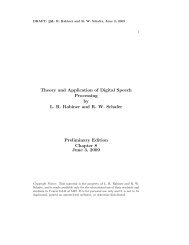Theory and Application of Digital Speech Processing by L. R. ...
Theory and Application of Digital Speech Processing by L. R. ...
Theory and Application of Digital Speech Processing by L. R. ...
Create successful ePaper yourself
Turn your PDF publications into a flip-book with our unique Google optimized e-Paper software.
DRAFT: L. R. Rabiner <strong>and</strong> R. W. Schafer, June 3, 2009<br />
16 CHAPTER 1. INTRODUCTION TO DIGITAL SPEECH PROCESSING<br />
<strong>of</strong> news, sporting events, television shows, <strong>and</strong> whatever other entertainment<br />
they deem interesting <strong>and</strong> appropriate on a small portable device.<br />
Perhaps the preeminent usage <strong>of</strong> speech technology in h<strong>and</strong>held devices is<br />
the speech coding that enables normal voice conversations in cell phones (based<br />
on speech coding at bit rates on the order <strong>of</strong> 8 Kbps), as well as the voice<br />
dialing capability that retrieves names <strong>and</strong> automatically dials the associated<br />
numbers <strong>by</strong> recognizing simple voice comm<strong>and</strong>s. Name directories with upwards<br />
<strong>of</strong> several hundred names can readily be recognized <strong>and</strong> dialed using simple<br />
speech recognition technology.<br />
Other key applications <strong>of</strong> speech technology include hearing aids (both the<br />
amplification type as well as the more sophisticated compression technology that<br />
does auditory analysis comparable to a human cochlea <strong>and</strong> feeds the resulting<br />
signals to the inner hair cells) <strong>and</strong> MP3 audio players that store up to several<br />
thous<strong>and</strong> coded songs (in MP3 or AAC format) on a hard disk <strong>and</strong> enable the<br />
music to be played virtually anywhere.<br />
Figure 1.7: Apple iPod Player<br />
Figure 1.7 shows the Apple iPod music player that has a hard disk with up<br />
to 80 GB <strong>of</strong> memory that can store about 24,000 songs, or the equivalent <strong>of</strong><br />
about 1200 CDs in compressed format. More than 120 million iPods have been<br />
sold <strong>by</strong> the end <strong>of</strong> 2007.<br />
Figure 1.8 shows the architecture <strong>of</strong> a modern cellular phone. One <strong>of</strong> the<br />
most important parts <strong>of</strong> the cellphone is the DSP chip that is used for speech<br />
coding <strong>and</strong> for speech recognition <strong>of</strong> user names <strong>and</strong> numbers. More than 1.2<br />
billion such cellphones were sold throughout the world in 2007.<br />
1.7 The <strong>Speech</strong> Chain [10]<br />
The goal <strong>of</strong> this book is to provide an underst<strong>and</strong>ing <strong>of</strong> the nature <strong>of</strong> the speech<br />
signal, <strong>and</strong> how digital signal processing techniques, along with communication<br />
technologies <strong>and</strong> information theory methods can be applied to help enable the<br />
various application scenarios described in the preceding section. We will see<br />
that the main emphasis <strong>of</strong> speech signal processing is the process <strong>of</strong> converting

















